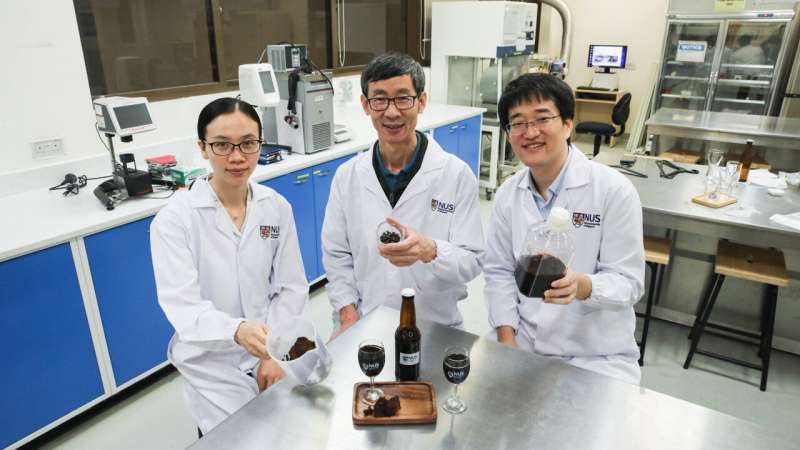by National University of Singapore

Spent coffee grounds (SCG) makes up the largest portion of waste generated from preparing coffee beverages and making instant coffee, producing close to 6 million metric tons of waste worldwide each year. To manage this vast amount of waste, scientists are finding ways of converting SCG into value-added products for various applications, from industrial materials to biofuels.
A team of researchers led by Associate Professor Liu Shao Quan from the NUS Department of Food Science and Technology under the Faculty of Science took a more innovative route to create an alcoholic beverage from fermented SCG as a way to sustainably manage the rising amount of waste generated from coffee consumption each year.
The team’s research on SCG-derived alcoholic beverages spanned across different studies where they worked on the flavor, aroma, and understanding its health benefits.
Achieving the best flavor and aroma
To prepare the alcoholic beverage from SCG, the researchers first prepared SCG hydrolysates, then fermented the SCG hydrolysates using a concoction of microorganisms, such as yeasts. Yeast plays an important role in the taste and aroma of the final product by influencing the chemical composition and quality of alcoholic beverages.
Assoc Prof Liu and his team demonstrated in a study published in 2021 in the journal LWT a method using two types of yeasts supplemented with yeast extracts for the fermentation process, allowing them to discover an effective way of creating an SCG-derived alcoholic beverage with a complex flavor palette.
“Alcoholic beverages are traditionally made using Saccharomyces yeasts. We took a different approach to making SCG-derived alcoholic beverages by exploring non-Saccharomyces yeasts for novel flavors and other characteristics,” said Assoc Prof Liu.
Following that study, the NUS team explored the use of other microorganisms, such as lactic acid bacteria with yeast, for fermentation to improve the smell and taste of the SCG-derived alcoholic beverage. The team used a mixture of yeast (Lachancea thermotolerans) and a lactic acid bacterium (Lactiplantibacillus plantarum) to ferment SCG hydrolysates to produce alcoholic beverages with different alcohol contents and physicochemical profiles.
This method resulted in higher contents of compounds related to a pleasant aroma and taste when compared to fermenting SCG hydrolysates with only yeast. The results of this fermentation strategy were published this year on 9 March 2023 in the journal Foods.
In their latest study, published in the journal Food Research International , the team adopted the fermentation strategy using this mixture of yeast and lactic acid bacteria for fermenting SCG hydrolysates. The team went a step further to conduct a detailed metabolomic analysis to identify the bioactive compounds present in the alcoholic beverage and determine its potential health benefits.
Identifying compounds that confer potential health benefits
The researchers adopted an advanced analytical technique known as liquid chromatography quadrupole time of flight mass spectrometry (LCQTOF-MS)—commonly used to identify and confirm the presence of chemical compounds in foods and beverages—to obtain a comprehensive picture of the chemical contents of the fermented SCG.
This study is the first time such an approach was used to determine a full profile of all the compounds present in SCG hydrolysates fermented by a combination of yeast and bacteria.
Through the analysis, the research team identified that fermentation of SCG hydrolysates through both yeast and bacteria boosted the presence of bioactive compounds associated with various health benefits, including anticancer, anti-inflammatory, and antimicrobial activities.
Dr. Liu Yunjiao, the first author of the most recent study, shared that the team developed several prototypes of the alcoholic beverages derived from SCG, all of which had varying flavor profiles.
“Some prototypes retained a coffee flavor, and for others, we’ve managed to achieve a pleasant flavor without a strong coffee flavor. Aside from the different flavor profiles, our tests showed that all the prototypes retained compounds that are known to confer health benefits, such as alkaloids and phenolic acids,” said Dr. Liu.
More information: Yunjiao Liu et al, Untargeted LC-QTOF-MS/MS-based metabolomics of spent coffee grounds alcoholic beverages fermented with Lachancea thermotolerans and Lactiplantibacillus plantarum, Food Research International (2023). DOI: 10.1016/j.foodres.2023.112733
Provided by National University of Singapore

